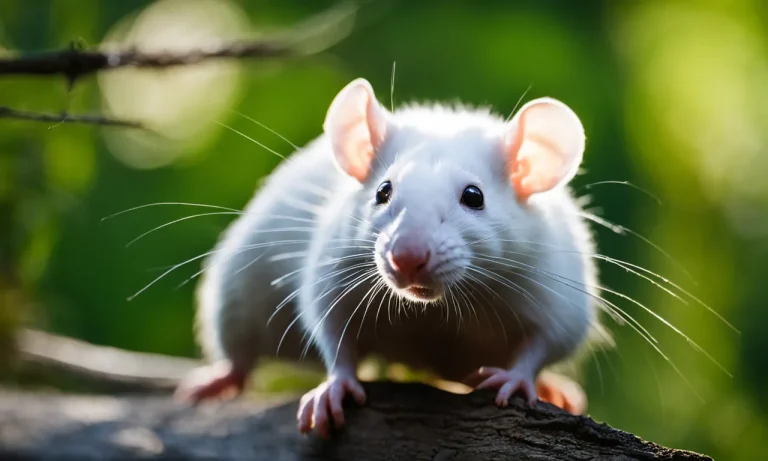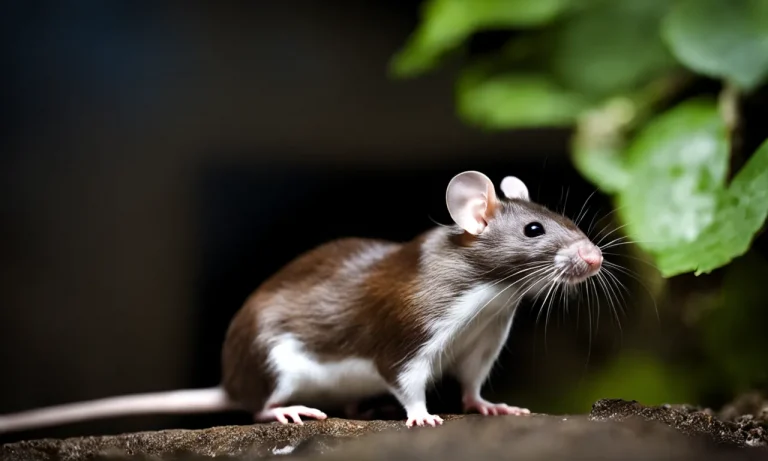Rats often get a bad rap, but why exactly do so many people harbor an intense dislike or even fear of these rodents? If you’re looking for a deep dive into the reasons behind widespread rat aversion, you’ve come to the right place.
In short: People hate rats mainly due to historical associations with disease, the rats’ rodent anatomy, and nuisance problems they can cause if populations grow unchecked in human areas.
In this approximately 3000 word article, we’ll explore the historical, cultural, psychological, and practical reasons that explain why rats bother us so much, even in our modern world.
Rats and Disease: A Long, Sordid History
Throughout history, rats have been closely associated with disease and have garnered a reputation as carriers of various illnesses. This negative perception stems from several significant events and factors that have contributed to the aversion towards rats.
The Black Plague
The most notorious and devastating disease associated with rats is undoubtedly the Black Plague. During the 14th century, this deadly pandemic swept through Europe, claiming the lives of millions. Rats, specifically the fleas that infested them, were identified as the primary carriers of the bacterium Yersinia pestis, which caused the plague.
The rapid spread of the disease was facilitated by the rat population, which thrived in densely populated areas and unsanitary conditions.
Early America and Urbanization
As urbanization took hold in early America, rats found a perfect habitat in crowded cities and towns. Lack of proper waste management and sanitation practices only exacerbated the problem. Rats became synonymous with filth and disease, as they were frequently found in close proximity to areas where garbage and sewage accumulated.
This association further solidified the negative perception of rats.
Rat Allergies and Health Concerns Today
While the Black Plague is a distant memory, rats still pose health risks today. One of the main concerns is rat allergies. Rat urine, droppings, and dander contain allergens that can trigger allergic reactions in sensitive individuals.
These reactions can range from mild symptoms, such as sneezing and itchy eyes, to more severe respiratory issues. Asthma sufferers, in particular, may experience worsened symptoms when exposed to rats or their allergens.
Additionally, rats can transmit several diseases to humans through direct contact, contaminated food, or vectors such as fleas and ticks. These diseases include leptospirosis, hantavirus, and salmonellosis.
It is important to note that while these diseases are rare, they still highlight the potential health risks associated with rats.
For more information on rat-borne diseases and prevention measures, you can visit the Centers for Disease Control and Prevention (CDC) website.
The Rodent Factor: Rats’ Unpleasant Physical Features
When it comes to rat aversion, one cannot ignore the impact of their physical appearance. Rats possess several features that are widely considered unpleasant and contribute to the negative perception that many people have towards them. Let’s take a closer look at some of these features:
Ugly Tails, Tiny Eyes, and Protruding Teeth
Rats are known for their long, scaly tails that can be quite off-putting to many individuals. These hairless appendages, which are often associated with disease and filth, can trigger a strong aversion response in people.
Additionally, rats have small beady eyes that can give off an eerie and unsettling vibe. Their teeth, which constantly grow throughout their lives, can also be a source of unease as they are often visible and protrude from their mouths.
It is important to note that while these physical features may contribute to rat aversion, they do not necessarily reflect the true nature or behavior of rats. Rats, like any other living creature, have their own unique set of characteristics and play an important role in ecosystems.
Unclean Grooming Habits
In addition to their physical appearance, rats’ grooming habits can also contribute to the negative perception people have towards them. Rats are known to groom themselves frequently, using their saliva to clean their fur.
While this may seem like a hygienic behavior, it can also give the impression of uncleanliness to those who are not familiar with their grooming habits. This perception is further reinforced by the fact that rats are often associated with unsanitary environments such as sewers or garbage dumps.
Scurrying and Gnawing Noises
One of the reasons why rats can be so unsettling to people is the sounds they make. Rats are agile creatures that can move quickly and silently, making them difficult to detect. The sound of their scurrying feet and the scratching and gnawing noises they make when exploring their surroundings can be quite alarming to those who are not accustomed to them.
These noises can create a sense of unease and contribute to the negative perception of rats.
It is important to remember that while rats may have physical features and behaviors that some people find unpleasant, they are still living beings that deserve understanding and respect. Taking the time to learn more about rats and their role in the natural world can help dispel some of the misconceptions and fears associated with them.
When Rats Invade: Practical Problems and Nuisances
When rats invade an area, they can cause a range of practical problems and nuisances that can be quite frustrating for humans. From property damage to aggressive behavior, their presence can disrupt our lives in numerous ways.
Property Damage and Contamination
Rats are notorious for causing property damage. They have sharp teeth that can chew through various materials, including wood, plastic, and even electrical wires. This can lead to structural damage to buildings and homes, as well as pose fire hazards.
Additionally, rats are known to contaminate food and other surfaces with their droppings and urine, increasing the risk of diseases such as leptospirosis and hantavirus.
Aggressive Behavior
Rats can exhibit aggressive behavior, especially when they feel threatened or cornered. This can be particularly concerning in urban areas where encounters with humans are more common. While rare, rat bites can occur and may pose health risks, as rats can transmit diseases such as rat-bite fever and tularemia.
Their aggressive behavior can also be a cause of distress for individuals who have a fear or phobia of rats.
Difficulty Controlling Populations
Rats are prolific breeders, and their populations can quickly grow out of control if not managed effectively. This can make it challenging to control their numbers and prevent further invasions. Traditional methods of rat control, such as traps and poisons, may be effective to some extent, but rats can adapt and develop resistance to these methods over time.
Additionally, their ability to hide in small crevices and navigate complex environments makes it difficult to completely eradicate them from an area.
Rats in Culture: Villains and Vermin
Rats have long been associated with negative connotations in various cultures around the world. They have often been portrayed as villains and vermin, evoking feelings of fear, disgust, and hatred. This aversion towards rats can be traced back to several factors, including their negative portrayals in fables and fiction, their associations with backwardness and poverty, and their links with betrayal and dishonesty.
Negative Portrayals in Fables and Fiction
Rats have frequently been depicted as cunning and deceitful characters in fables and fiction. One classic example is the story of “The Pied Piper of Hamelin,” where rats are portrayed as pests that wreak havoc on a town.
Their negative portrayal in such stories has contributed to the perception of rats as untrustworthy and dangerous creatures. Additionally, movies and literature often depict rats as carriers of diseases, further fueling the fear and disgust associated with them.
Associations with Backwardness and Poverty
Rats are often found in areas associated with poverty and unsanitary conditions. They thrive in environments where there is easy access to food and shelter. As a result, rats have become symbols of backwardness and poverty.
This association has led to a negative perception of rats and the belief that they are carriers of diseases and filth. It is important to note, however, that rats can be found in both urban and rural areas, and their presence is not necessarily indicative of poverty.
Links with Betrayal and Dishonesty
Rats have also been linked with betrayal and dishonesty in popular culture. The phrase “ratting someone out” refers to betraying a person’s trust by revealing their secrets or wrongdoing. This association has further contributed to the negative image of rats and the perception that they are untrustworthy creatures.
However, it is important to remember that this is purely a metaphorical association and does not reflect the actual behavior of rats in their natural habitats.
While these negative perceptions of rats have persisted throughout history, it is essential to approach them with a balanced perspective. Rats, like any other animal, play an important role in ecosystems and have their own unique behaviors and characteristics.
Understanding the reasons behind rat aversion can help dispel unfounded fears and promote a more compassionate and informed view of these creatures.
Overcoming Odium: Rats and Human Psychology
When it comes to rats, it is no secret that many people harbor a deep aversion towards these creatures. From horror movies to urban legends, rats have long been associated with filth, disease, and destruction. But why do people hate rats so much?
To understand this phenomenon, we need to delve into the realm of human psychology.
Instinctive and Learned Fear Responses
One of the main reasons for the aversion towards rats is rooted in our evolutionary past. Throughout history, rats have been carriers of diseases such as the bubonic plague, which caused widespread devastation.
This association between rats and disease has been deeply ingrained in our collective psyche, leading to an instinctive fear response when encountering these creatures.
Furthermore, humans also develop aversions through learned experiences. For example, if someone had a negative encounter with a rat in their childhood, such as an infestation in their home, they may develop a lasting fear or dislike towards rats.
This learned aversion can be difficult to overcome, as it is deeply rooted in personal experiences.
Cognitive Biases Against Rats
Another factor contributing to the hatred towards rats is the presence of cognitive biases. Cognitive biases are systematic errors in thinking that can influence our perception and judgment. In the case of rats, there are several biases that come into play.
One such bias is the availability heuristic, which leads us to judge the likelihood of an event based on how easily it comes to mind. Since negative stories and images of rats are more readily available in our minds, we tend to overestimate the dangers and negative traits associated with rats.
Confirmation bias also plays a role, as we tend to seek out information that confirms our existing beliefs. If someone already believes that rats are filthy and disease-ridden, they are more likely to focus on and remember instances that support this belief, further reinforcing their aversion towards rats.
Efforts to Rehabilitate the Rat’s Image
Despite the widespread dislike towards rats, there have been efforts to rehabilitate their image and challenge the negative stereotypes surrounding them. Scientists and animal welfare organizations have been working to highlight the positive aspects of rats, such as their intelligence and social behavior.
Rats have been used in various research studies due to their similarities to humans in terms of physiology and behavior. They have contributed to advancements in fields such as medicine and psychology.
By showcasing these positive contributions, the hope is to change public perception and encourage a more balanced view of rats.
Furthermore, some individuals have taken it upon themselves to keep rats as pets, sharing their experiences and bonding with these creatures. These personal stories and interactions can help challenge preconceived notions and humanize rats in the eyes of others.
Conclusion
While rat aversion is deeply ingrained in many human cultures, taking a closer look at the historical and psychological reasons behind this reveals that much rat hatred stems from misconceptions. With greater scientific understanding and more balanced portrayals in media, perhaps rats can someday overcome their unsavory reputations.
Rats are just one small part of nature’s grand diversity, not the monsters we sometimes make them out to be. If we can move past our instinctive prejudices, we may find rats have much to teach us about resilience, family bonds, and even humanity’s own complex relationship with the natural world.






